Sustainable forestry prioritizes maintaining ecosystem health, biodiversity, and long-term productivity by using selective harvesting methods and promoting natural regeneration. Conventional logging often leads to deforestation, habitat destruction, and soil degradation due to clear-cutting and lack of environmental safeguards. Sustainable practices reduce carbon emissions and protect water quality, making them essential for preserving forest environments and combating climate change.
Table of Comparison
| Aspect | Sustainable Forestry | Conventional Logging |
|---|---|---|
| Environmental Impact | Minimizes habitat destruction and promotes biodiversity | Often leads to deforestation and habitat loss |
| Resource Management | Ensures long-term forest regeneration and health | Focuses on short-term timber extraction |
| Soil Protection | Maintains soil quality and prevents erosion | Increases soil degradation and erosion risk |
| Carbon Sequestration | Supports carbon storage through managed growth | Reduces carbon storage due to tree removal |
| Economic Benefits | Promotes sustainable jobs and long-term yield | Generates quick profits, often unsustainable |
| Certification | Often certified (FSC, PEFC) for eco-friendly practices | Rarely certified, less regulated |
Introduction to Sustainable Forestry and Conventional Logging
Sustainable forestry prioritizes long-term ecosystem health by maintaining biodiversity, soil quality, and water resources while enabling continuous timber production. Conventional logging often emphasizes short-term economic gain, leading to habitat destruction, soil erosion, and reduced forest regeneration capacity. Managing forests sustainably involves regulated harvesting, reforestation practices, and conservation measures that balance ecological integrity with human economic needs.
Key Principles of Sustainable Forestry Practices
Sustainable forestry prioritizes maintaining biodiversity, protecting soil and water quality, and ensuring long-term forest health by employing selective harvesting and reforestation techniques. Key principles include minimizing ecological impact, supporting habitat conservation, and balancing economic needs with environmental stewardship. These practices contrast with conventional logging, which often emphasizes short-term timber extraction without regard for regeneration or ecosystem stability.
Conventional Logging: Methods and Impacts
Conventional logging primarily involves clear-cutting and selective logging, often leading to significant deforestation and habitat loss. This method disrupts soil structure, increases erosion, and diminishes biodiversity due to the removal of mature trees without adequate regeneration. These environmental impacts contribute to climate change by releasing stored carbon and reducing the forest's capacity to act as a carbon sink.
Ecological Benefits of Sustainable Forestry
Sustainable forestry enhances biodiversity by preserving habitats and maintaining ecosystem balance, unlike conventional logging which often leads to habitat loss and soil degradation. It promotes carbon sequestration through selective tree harvesting and continuous canopy cover, helping mitigate climate change effects. Water quality improves as sustainable practices reduce erosion and protect watersheds, supporting overall ecosystem health.
Environmental Consequences of Conventional Logging
Conventional logging significantly contributes to deforestation, habitat destruction, and biodiversity loss, disrupting ecosystems and altering natural carbon cycles. The removal of trees without adequate reforestation leads to soil erosion, decreased water quality, and increased greenhouse gas emissions due to reduced carbon sequestration. This environmental degradation contrasts with sustainable forestry practices that prioritize ecosystem health and long-term resource availability.
Economic Considerations: Sustainable Forestry vs. Conventional Logging
Sustainable forestry promotes long-term economic benefits by maintaining ecosystem health, ensuring continuous timber production, and supporting local communities through diversified income sources like ecotourism. Conventional logging often yields short-term financial gains but risks resource depletion, leading to increased costs for reforestation and loss of biodiversity, which can reduce future economic opportunities. Investments in sustainable practices improve market competitiveness by meeting growing consumer demand for eco-friendly products and complying with environmental regulations.
Social Impacts on Local Communities
Sustainable forestry promotes social well-being by preserving local livelihoods through responsible resource management, ensuring long-term access to forest products and ecosystem services. In contrast, conventional logging often leads to social conflicts, displacement, and loss of traditional land rights for indigenous and local communities. Sustainable practices foster community participation and empower stakeholders, enhancing social cohesion and cultural preservation.
Certifications and Policies Promoting Sustainable Forestry
Sustainable forestry benefits from certifications such as FSC (Forest Stewardship Council) and PEFC (Programme for the Endorsement of Forest Certification), which ensure responsible forest management practices that protect biodiversity and promote regeneration. Government policies like the EU Forest Strategy and the U.S. Lacey Act support these certifications by enforcing regulations that prevent illegal logging and promote transparency in timber trade. These certifications and policies collectively foster sustainable resource use while mitigating the environmental impacts associated with conventional logging methods.
Case Studies: Success Stories in Sustainable Forest Management
Case studies highlighting sustainable forest management demonstrate significant improvements in biodiversity conservation and carbon sequestration compared to conventional logging practices. Projects like the Amazon REDD+ initiative and Finland's Metsahallitus Sustainable Forestry program showcase how community involvement and strict regulatory frameworks lead to reduced deforestation rates and enhanced ecosystem services. These success stories emphasize the economic viability of sustainable forestry through certified timber markets and ecosystem service payments.
The Future of Forests: Transitioning to Sustainable Practices
Sustainable forestry prioritizes ecosystem health, biodiversity preservation, and carbon sequestration, enabling long-term forest resilience compared to conventional logging's short-term resource extraction. Innovations such as selective harvesting, reduced-impact logging, and reforestation efforts enhance soil quality and water retention, supporting climate change mitigation goals. Transitioning to sustainable practices is crucial for maintaining forest ecosystem services, protecting wildlife habitats, and ensuring economic viability for future generations.
sustainable forestry vs conventional logging Infographic

 difterm.com
difterm.com